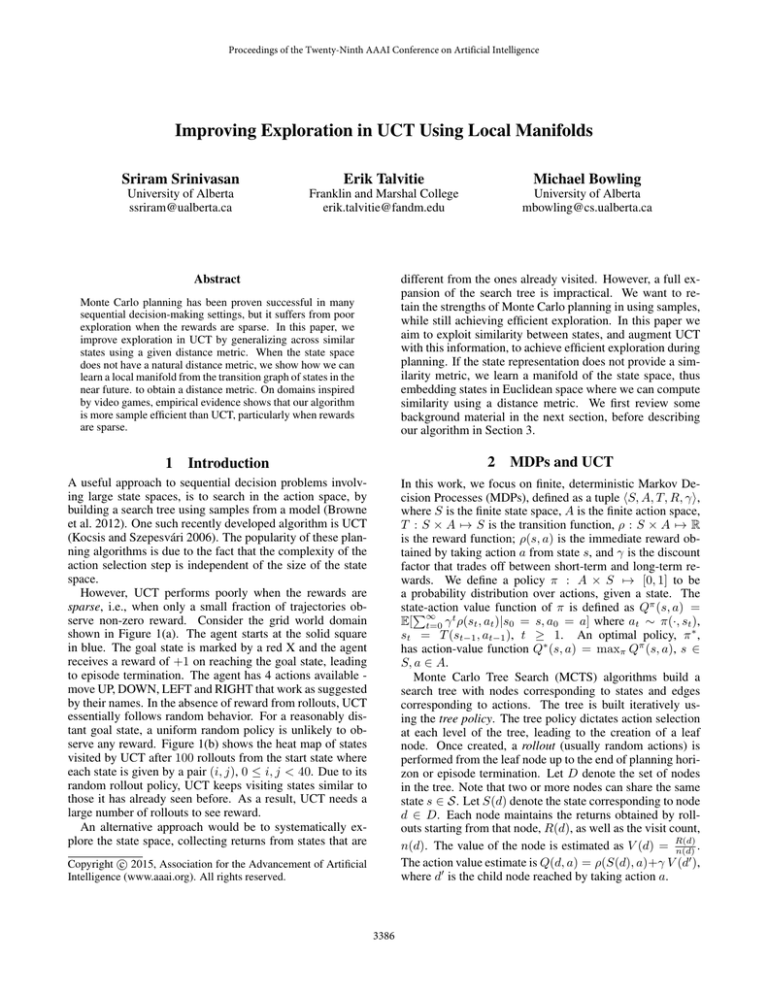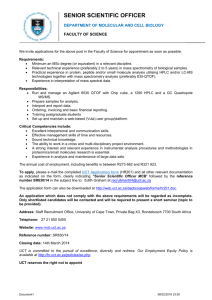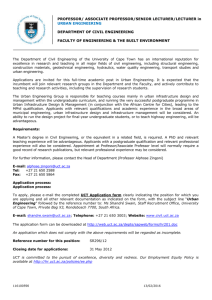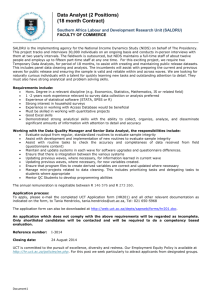
Proceedings of the Twenty-Ninth AAAI Conference on Artificial Intelligence
Improving Exploration in UCT Using Local Manifolds
Sriram Srinivasan
Erik Talvitie
Michael Bowling
University of Alberta
ssriram@ualberta.ca
Franklin and Marshal College
erik.talvitie@fandm.edu
University of Alberta
mbowling@cs.ualberta.ca
Abstract
different from the ones already visited. However, a full expansion of the search tree is impractical. We want to retain the strengths of Monte Carlo planning in using samples,
while still achieving efficient exploration. In this paper we
aim to exploit similarity between states, and augment UCT
with this information, to achieve efficient exploration during
planning. If the state representation does not provide a similarity metric, we learn a manifold of the state space, thus
embedding states in Euclidean space where we can compute
similarity using a distance metric. We first review some
background material in the next section, before describing
our algorithm in Section 3.
Monte Carlo planning has been proven successful in many
sequential decision-making settings, but it suffers from poor
exploration when the rewards are sparse. In this paper, we
improve exploration in UCT by generalizing across similar
states using a given distance metric. When the state space
does not have a natural distance metric, we show how we can
learn a local manifold from the transition graph of states in the
near future. to obtain a distance metric. On domains inspired
by video games, empirical evidence shows that our algorithm
is more sample efficient than UCT, particularly when rewards
are sparse.
1
2
Introduction
A useful approach to sequential decision problems involving large state spaces, is to search in the action space, by
building a search tree using samples from a model (Browne
et al. 2012). One such recently developed algorithm is UCT
(Kocsis and Szepesvári 2006). The popularity of these planning algorithms is due to the fact that the complexity of the
action selection step is independent of the size of the state
space.
However, UCT performs poorly when the rewards are
sparse, i.e., when only a small fraction of trajectories observe non-zero reward. Consider the grid world domain
shown in Figure 1(a). The agent starts at the solid square
in blue. The goal state is marked by a red X and the agent
receives a reward of +1 on reaching the goal state, leading
to episode termination. The agent has 4 actions available move UP, DOWN, LEFT and RIGHT that work as suggested
by their names. In the absence of reward from rollouts, UCT
essentially follows random behavior. For a reasonably distant goal state, a uniform random policy is unlikely to observe any reward. Figure 1(b) shows the heat map of states
visited by UCT after 100 rollouts from the start state where
each state is given by a pair (i, j), 0 ≤ i, j < 40. Due to its
random rollout policy, UCT keeps visiting states similar to
those it has already seen before. As a result, UCT needs a
large number of rollouts to see reward.
An alternative approach would be to systematically explore the state space, collecting returns from states that are
MDPs and UCT
In this work, we focus on finite, deterministic Markov Decision Processes (MDPs), defined as a tuple hS, A, T, R, γi,
where S is the finite state space, A is the finite action space,
T : S × A 7→ S is the transition function, ρ : S × A 7→ R
is the reward function; ρ(s, a) is the immediate reward obtained by taking action a from state s, and γ is the discount
factor that trades off between short-term and long-term rewards. We define a policy π : A × S 7→ [0, 1] to be
a probability distribution over actions, given a state. The
π
state-action
P∞ t value function of π is defined as Q (s, a) =
E[ t=0 γ ρ(st , at )|s0 = s, a0 = a] where at ∼ π(·, st ),
st = T (st−1 , at−1 ), t ≥ 1. An optimal policy, π ∗ ,
has action-value function Q∗ (s, a) = maxπ Qπ (s, a), s ∈
S, a ∈ A.
Monte Carlo Tree Search (MCTS) algorithms build a
search tree with nodes corresponding to states and edges
corresponding to actions. The tree is built iteratively using the tree policy. The tree policy dictates action selection
at each level of the tree, leading to the creation of a leaf
node. Once created, a rollout (usually random actions) is
performed from the leaf node up to the end of planning horizon or episode termination. Let D denote the set of nodes
in the tree. Note that two or more nodes can share the same
state s ∈ S. Let S(d) denote the state corresponding to node
d ∈ D. Each node maintains the returns obtained by rollouts starting from that node, R(d), as well as the visit count,
n(d). The value of the node is estimated as V (d) = R(d)
n(d) .
The action value estimate is Q(d, a) = ρ(S(d), a)+γ V (d0 ),
where d0 is the child node reached by taking action a.
c 2015, Association for the Advancement of Artificial
Copyright Intelligence (www.aaai.org). All rights reserved.
3386
(a) Grid World
(b) Heat map of UCT after 100 rollouts
(c) Heat map of NN-UCT after 100 rollouts
Figure 1: UCT on Grid World
ular choice for the kernel function when states are real0
valued
vectors,
is the Gaussian kernel function, K(s, s ) =
0
k2
exp ks−s
, where σ is the Gaussian width parameter
σ
which controls the degree of generalization. As σ → 0, the
nearest neighbor estimate approaches the combined MC estimate of all the nodes that share the same state. Note that
the nearest neighbor estimate adds bias, which could prevent
the guarantee of continual exploration of all actions. Hence,
asymptotically, we want the returns and visit count estimates
to be closer to the unbiased MC estimates. One resolution
is to employ a decay scheme that changes the similarity over
time so that the similarity between distinct states converges
to zero. For example, with a Gaussian kernel function, the
Gaussian widths of the nodes can be shrunk to zero as planning continues. In Section 3.1, we discuss one such scheme
for reducing σ smoothly over time. The new UCB score is
computed as
s
P
2 ln a0 ∈A nnn (d, a0 )
.
Qucb (d, a) = Qnn (d, a) + C
nnn (d, a)
UCT (Kocsis and Szepesvári 2006) is an MCTS algorithm, that uses the UCB1 algorithm (Auer, Cesa-Bianchi,
and Fischer 2002) for its tree policy. At each step in the
tree policy, UCT treats the action selection step, as a multiarmed bandit problem. It computes a UCB score and picks
the action corresponding to the highest score. The score for
node d and action a is given by
s
P
2 ln a0 ∈A n(d, a0 )
.
Qucb (d, a) = Q(d, a) + C
n(d, a)
The second term is a so-called exploratoration bonus, which
encourages actions taken less frequently from a node, where
C is a positive parameter, n(d, a) is the number of times,
action a was taken from node d and hence n(d, a) = n(d0 ),
where d0 isPthe child node reached by taking action a. We
also have a∈A n(d, a) = n(d). After the computational
budget is exhausted in building the tree the greedy action at
the root, arg maxa∈A Q(d0 , a), is picked, breaking ties by
choosing the most frequent action arg maxa∈A n(d0 , a).
3
NN-UCT
Here Qnn (d, a) = ρ(S(d), a) + γVnn (d0 ), where d0 is the
child node of node d when action a is taken from state S(d).
The quantity, nnn (d, a) ≡ nnn (d0 ), is taken from the child
node d0 . Thus, the nearest neighbor estimate of the number
of times action a was taken from state S(d) is obtained from
0
the number of state visits
P to the after-state S(d ). In our algorithm, unlike UCT, a∈A nnn (d, a) 6= nnn (d). Neither
the actual visit count (n(d)), nor the nearest neighbor estimate (nnn (d)) of the parent node is used in the exploration
term. Only the estimates of the child nodes (after-states) are
used for action selection and actions leading to after-states
similar to the ones already explored are not preferred. The
idea of using after-state counts in the exploration bonus has
been explored previously (Méhat and Cazenave 2010), but
they did not incorporate generalization. Figure 1(c) shows
the heat map of states visited by NN-UCT on the grid world
domain after 100 rollouts from the start state and a Gaussian
kernel with σ = 100 is used with a decay scheme (explained
By adding generalization in the UCB score, a good estimate
of the node’s statistics can be obtained from the statistics of
other nodes in the tree, thus making better use of samples.
A natural way to incorporate generalization is to combine
the statistics of similar nodes. One way to achieve this is to
compute a nearest neighbor estimate of the return and visit
counts for each node d, as given by
X
Rnn (d) =
K(S(d), S(d0 ))R(d0 ) ,
d0 ∈D
nnn (d) =
X
K(S(d), S(d0 ))n(d0 ) ,
d0 ∈D
Vnn (d) =
Rnn (d)
,
nnn (d)
where K(s, s0 ) is a nonnegative valued kernel function
that measures similarity between states s and s0 . A pop-
3387
−10
0
10
−10
0
10
(b) Manifold Embedding of 20 × 20 grid with wall
(a) Grid World
Figure 2: Grid World with Wall
in the next section) that uses β = 0.9. NN-UCT directs the
tree to be grown in areas farther from states that have been
encountered already. In the absence of reward, with ties broken using visit counts, the action picked at the root would be
one that leads to a state in the direction of under-explored
states, in this case ”UP”. Thus the NN estimates not only
help guide tree expansion, but also action selection when no
rewards are encountered during planning.
3.1
ing fast computation of distances between states. Low dimensional manifolds are a natural choice that satisfy all the
requirements.
4
A manifold M ⊂ R is a set of points such that the Euclidean distance between nearby points on the manifold approximates the true distances between those points. Figure 2(b) shows an example of a 2D manifold of a 20 × 20
grid, with a wall as shown. Manifold learning (Ma and Fu
2012) typically involves learning a low-dimensional representation, subject to distance preserving constraints. Manifold learning algorithms rely on the geodesic distances between neighboring points, while approximating other distances. Euclidean distance between points on the manifold
can then serve as a distance metric for measuring similarity
of points. Thus, the similarity measure needed in our NNUCT algorithm can be obtained by embedding the states on
a manifold.
We can embed the states by applying a manifold learning algorithm on the distance matrix constructed from the
transition graph of states in the MDP. The computational
complexity of most manifold learning algorithms is O m3 ,
where m is the number of points needed to be embedded.
This cost is due to the distance matrix construction and subsequent eigen-decomposition. Hence, it is computationally
infeasible to embed all of the possible states in large problems. One way to deal with the high computational cost of
embedding states on a manifold is to embed only those states
that may be encountered in the near future. As we are operating in the planning setting, with access to a model, we can
sample the states reachable in the near future and construct
a manifold that is local to the current state. We next describe
an algorithm to construct such a manifold.
Decay Scheme
In this section we discuss a decay scheme for Gaussian kernels. Given the initial Gaussian kernel width σ, we want
a scheme which shrinks the Gaussian widths of nodes such
that the value estimates and visit counts are closer to the
MC estimate, asymptotically. We use a simple exponential decay with rate governed by a parameter β ∈ (0, 1).
In this scheme, we shrink the Gaussian width of the child
nodes whenever the tree policy is executed at the parent
node. Thus, the Gaussian width of a node d0 is given by
σ(d0 ) = σβ n(d) , where n(d) is the count of the visits to
the parent node d. The Gaussian width of the root node is
shrunk after each rollout. This scheme ensures that if erroneous generalization has starved visits to d0 , it will eventually be explored once its parent has been visited sufficiently
often.
3.2
mNN-UCT
m
Generalization in Complex Domains
In the grid world example shown in Figure 1(a), the Euclidean distance between two points on the grid was a good
choice for a distance metric. However, in general, the grid
coordinates may not be the best representation. For example,
consider a grid world with a wall as shown in Figure 2(a).
In this case, distance between grid coordinates is not a good
distance metric, as states on either side of the wall are farther apart than those on the same side. Furthermore, not all
state representations have a natural metric space for defining
similarity. High dimensional state spaces pose an additional
problem of tractably computing a distance metric. Hence,
we need a state representation that captures the underlying
topology of the environment that is low dimensional, allow-
4.1
Local Manifolds
For computational feasibility, we learn a local manifold over
the state space. Local manifolds provide a topology of the
state space in the local neighborhood of the current state. In
our work, at every decision step, we learn a local manifold of
3388
1000
400
800
Steps to Goal
Steps to Goal
500
300
200
100
0
UCT
NN−UCT
mNN−UCT(0)
mNN−UCT
600
400
200
0
mNN−UCT−g
(a) Grid
UCT
NN−UCT
mNN−UCT(0)
mNN−UCT
mNN−UCT−g
(b) Grid with wall
Figure 3: Performance on Grid World Domains
the deterministic MDP from the sample transitions encountered during a short breadth-first walk of the state space,
starting from the current state. We construct the distance
matrix of the all-pairs shortest path distances between states
in the BFS tree with distance between two states measured
as the minimum number of actions required to get from one
to the other. We apply the Isomap algorithm (Tenenbaum,
De Silva, and Langford 2000) on the distance matrix to generate a Euclidean embedding of the states. This ensures that
states that are nearby in time are nearby in space as well.
During UCT planning, we may encounter states that were
not encountered in the BFS walk, and therefore do not have
an embedding. This situation is referred to as the out-ofsample problem and is more likely to occur as the UCT tree
grows larger. If we were to embed these states on a manifold, we would need a deeper BFS walk from the start state,
resulting in a possibly exponential increase in the number of
states to be embedded.
We address the out-of-sample problem in the following
way. We generate the approximate embeddings of out-ofsample states by applying an operator learnt for each action
in the action set. We learn this operator from the manifold embeddings of the states encountered during the BFS
walk for the local manifold. Let Mk denote the set of tuples
hx, k, yi, such that y is the manifold embedding of the state
obtained by taking action k ∈ A from the state with manifold embedding x. We learn a simple translation operator
fk (x) = x + bk for this action where bk is given by
X
1
bk =
ky − xk2 .
|Mk |
length of length 50, rather than out to a fixed horizon. This
helped prevent finite horizon effects from affecting generalization. The optimal branch of the UCT tree and the BFS
tree were retained across planning steps. A wide range
{10−5 , 10−4 , . . . , 103 , 104 } was tested for the UCB parameter with 500 trials performed for each parameter setting.
5.1
We first validate our intuitions about the impact of state generalization in UCT by evaluating the algorithms on the two
grid world domains shown in Figures 1 and 2 and described
in Sections 1 and 3.2. An episode terminates when the agent
reaches the goal state, or 1000 time-steps have elapsed,
whichever occurs first. We report the number of steps taken
to reach the goal state using 100 rollouts for each planning
step. For the UCT algorithms with generalization, the Gaussian kernel function with an initial Gaussian width σ chosen
from {10, 100, 1000, 10000} was used, and the decay rate β
chosen from {0.1, 0.5, 0.9, 0.99}, and the best result is reported. The Euclidean distance was used for the distance
metric in the kernel function. For the mNN-UCT algorithm,
the BFS walk included at most 400 states for each planning
step. The mNN-UCT algorithm with σ = 10−6 , referred to
as mNN-UCT(0) essentially shares statistics only between
nodes with the same state. This tests whether generalizing
from similar states is helpful. mNN-UCT-g is the mNNUCT algorithm using a global instead of a local manifold,
where a full BFS walk is used to construct the manifold, allowing us to evaluate the effectivness of local manifolds.
Figure 3 summarizes the results of our grid world experiments. The mean number of steps (fewer steps being better), with standard error bars is shown. Sharing statistics
between nodes with exactly the same states (mNN-UCT(0))
improves UCT slightly. Adding more widespread generalization to UCT improves the performance dramatically in
both the domains, with the NN-UCT algorithm reaching the
goal state in less than half the number of steps taken by UCT
in the first domain. The best performing σ for the mNNUCT and mNN-UCT-g algorithms was substantially greater
than 0, suggesting that generalizing over nearby states in the
neighborhood of the manifold is useful. All the algorithms,
as expected, take more steps to reach the goal when the wall
is added. The NN-UCT algorithm, which uses the Euclidean
distance metric between grid coordinates, does not perform
t∈Mk ,t=hx,k,yi
We found the simple translation operator to be useful in the
domains tested here. Applying more sophisticated solutions
to the out-of-sample problem is a direction for future work.
NN-UCT with manifolds, referred to as mNN-UCT, uses
the manifold embedding to compute the kernel function. If
a state outside of the BFS walk is encountered during planning, its embedding is computed by applying the translation
operator to the state from which the current action was taken.
5
Grid World Domain
Experiments
In our UCT implementation, whenever a new node is created, a rollout (random actions) was run for a constant
3389
(a) Freeway
(b) Space Invaders
(c) Seaquest
Figure 4: Games Domains
reaches end of the screen. The agent receives a reward of
+1 if it collects the diver and drops it at the drop point (top
row, indicated in green). The agent loses its only life on
collision with a fish, or on reaching the drop point without
the diver. The actions available to the agent are: NO-OP,
UP, DOWN, LEFT and RIGHT. The maximum possible
score is 8 in the absence of fish, as it is impossible to capture any 2 successive divers and drop them at the drop
point, though this score may not be realizable.
as well in the second domain. The naive distance metric is
not as useful since states on either side of the wall are farther apart than the Euclidean distance indicates. mNN-UCT
does not suffer from this problem, as it better captures the
topology of the state space. In both the domains, using local manifolds rather than global manifolds does not substantially affect planning performance.
5.2
Game Domains
We also test our algorithm on three domains inspired by
video games. Each domain is a single player games played
on a 16 × 16 board. The initial configuration of the games
is shown in Figure 4. All the games last for 256 time-steps
or until the agent loses all of its lives, whichever is shorter.
The agent is depicted by the blue square.
1. Freeway: Cars are depicted by red chevrons. Their positions on each row and direction of movement is set arbitrarily at the start. On reaching the end of the board,
they reappear back on the opposite side. The agent has
3 lives. On collision, the agent loses a life and its position is reset to its start position. The agent has 3 actions:
NO-OP (do nothing), UP and DOWN. The agent receives
a reward of +1 on reaching the topmost row after which
the agent’s position is reset to start state. The maximum
possible score is 16 in the absence of cars, although with
cars, the optimal score is likely lower.
2. Space Invaders: The aliens are depicted by red triangles.
These aliens fire bullets vertically downward, at fixed intervals of 4 time-steps. The aliens move from left to right.
They change directions if the rightmost (or leftmost) alien
reaches the end of the screen. The agent loses its only life
if it gets hit by a bullet from the alien. The following
actions are available to the agent: NO-OP, FIRE, LEFT,
RIGHT, LEFT-FIRE (fire bullet and move left) and similarly RIGHT-FIRE (fire bullet and move right). The maximum possible score is 32 (reward of 1 for shooting an
alien) in the absence of the alien’s bullets, with a realizable score likely lower.
3. Seaquest: Fish depicted by red chevrons, move from left
to right and reappear back on reaching the end of the
screen. The diver, indicated by a black triangle, appears
at either end, alternately. The diver appears when the current diver is collected by the agent or if the current diver
In all of these domains the agent does not receive the positions of the various objects, and instead needs to rely on the
manifold over the transition graph to define similarity between states. Furthermore, learning a global manifold would
likely be high dimensional and computationally infeasible.
Performance Comparison. We compare mNN-UCT with
UCT on the domains described above. We again evaluate
the effect of generalization by running our algorithm with
σ = 10−6 referred to mNN-UCT(0). We ensure that all
of the algorithms are given the same number of samples
per planning step. We vary the number of rollouts from
{20, 40, 80, 160, 320}. The discount factor was set at 0.99.
We fix the other parameters for the mNN-UCT algorithm
with σ = 100, and β = 0.9. We learn a local manifold for
each planning step from a BFS tree comprising of at most
400 states. For each of the domains, we measure the mean
score obtained per episode over all 500 trials. The standard
errors are indicated as error bars. The optimistic maximum
score possible is indicated by a blue line. Note that it may
not be possible to achieve this score in all domains.
Figure 5 shows the performance of the 3 algorithms
against the number of rollouts. The results are reported for
the parameters which produced the best mean score obtained
by performing 500 trials. mNN-UCT outperforms UCT, especially in Freeway and Seaquest. Both these games require
the agent to perform a specific sequence of actions in order
to obtain non-zero reward. UCT’s rollout policy is sufficient to achieve a high score in Space Invaders as the game
does not have sparse rewards. Generalization using manifolds provides only a marginal improvement in this game.
Parameter Sensitivity. We evaluate the sensitivity of the
algorithm with respect to the parameters σ and β, which together control the degree of generalization in the UCT al-
3390
15
10
15
Mean Score
Mean Score
20
UCT
mNN−UCT(0)
mNN−UCT
5
0
20
40
80
160
10
UCT
mNN−UCT
5
0
−6
320
−4
Number of Rollouts
−2
(a) Freeway
Mean Score
Mean Score
10
20
40
80
160
25
−4
0
4
2
4
(b) Space Invaders
6
Mean Score
10
Mean Score
−2
Log10 UCB Constant
(b) Space Invaders
0
2
20
15
−6
320
UCT
mNN−UCT
Number of Rollouts
5
4
30
UCT
mNN−UCT(0)
mNN−UCT
20
0
2
(a) Freeway
40
30
0
Log10 UCB Constant
UCT
mNN−UCT(0)
mNN−UCT
20
40
80
160
4
2
0
−6
320
Number of Rollouts
UCT
mNN−UCT
−4
−2
0
Log10 UCB Constant
(c) Seaquest
(c) Seaquest
Figure 5: Performance on Games Domains
Figure 6: Parameter Sensitivity
gorithm. In this experiment, we fix the number of rollouts
at 100. We vary σ from {10, 100, 1000, 10000} and β in
{0.1, 0.5.0.9, 0.99}. For each parameter setting, we measure
the performance of the mNN-UCT algorithm and compare it
to UCT using various settings of the UCB parameter.
Scatter plots are shown in Figure 6 where each red square
represents the mean score per episode obtained by UCT with
a specific setting of the UCB parameter and blue x represents
the score obtained by mNN-UCT with a specific setting of σ
and β. We see that the mNN-UCT algorithm performs better
than UCT for a wide range of parameter settings in all the
domains. Using widespread generalization achieves significantly higher score on sparse reward games such as Freeway
and Seaquest, while the improvement is modest when rewards are easy to obtain in the game such as Space Invaders.
value estimates. We defer a formal proof to future work.
While we have shown empirically that state generalization
helps UCT, the improvement comes at an additional cost. In
our algorithm, the cost is due to manifold learning and computing the nearest neighbor estimates. The former is controlled by the size of the BFS walk. The latter is controlled
by the number of rollouts, which determines the number of
nodes in the tree. In our experiments, calls to the simulator
dominated the runtime cost, so the cost of manifold learning
was insignificant compared to the cost of planning. Furthermore, experimental results have shown that fewer rollouts
may be needed to achieve good performance and hence the
cost incurred by computing the nearest neighbor estimate
may be justified. For large UCT trees we can be more efficient by having a distance threshold beyond which neighbor
estimates are ignored using K-d trees (Bentley 1975).
6
Discussion
6.1
We observed that adding generalization improves UCT significantly in sparse reward conditions. By using the nearest
neighbor heuristic, we are effectively making the assumption that states located nearby in space also have similar values. Such an assumption may not hold in all domains, although in our experiments it proved helpful. Although the
decay scheme to shrink the Gaussian kernel widths of nodes
in the UCT tree should overcome any adverse effects of generalization, we do not have consistency guarantees on the
Related Work
A common enhancement to UCT is the use of transposition
tables (Childs, Brodeur, and Kocsis 2008). Transposition tables offer a basic form of generalization, by sharing statistics
of nodes in the UCT tree having the same state. Our algorithm with σ ≈ 0 closely resembles UCT with transposition
tables. Although transposition tables help speed up search,
they provide limited exploration benefit as they can only recognize state equality. In large state spaces, the likelihood of
3391
our algorithm substantially outperformed UCT with no generalization, especially in environments with sparse rewards.
encountering transpositions is low, and hence transposition
tables may be less useful. This was noticed even in our relatively small experimental domains, with more aggressive
generalization improving on basic transposition tables.
State abstraction using homomorphisms in UCT adds another layer of generalization by grouping states with the
same transition and reward distributions. The idea of using
local homomorphisms (Jiang, Singh, and Lewis 2014) as an
approximate state abstraction was an inspiration for the development of using local manifolds. The homomorphism
groups states together but, like transposition tables, it does
not have a degree of similarity, only a hard notion of equivalence. In the grid world domain in Figure 1(a), the only
homomorphism is the grid itself. Thus, homomorphisms are
no better than transposition tables in this case.
Another approach to generalization in UCT is Rapid Action Value Estimation (RAVE) (Gelly and Silver 2011).
RAVE uses the All-Moves-As-First (AMAF) heuristic which
states that the value of an action is independent of when it
is taken, i.e. if an action is profitable at a subtree τ (s), it
is profitable immediately at the root s as well. RAVE combines the Monte Carlo estimate with the AMAF estimate,
Qrave (s, a) = (1 − β)Q(s, a) + βQAM AF (s, a), where
0 < β < 1 is a weight parameter that decreases with increasing number of rollouts. The RAVE estimate is used in
place of Q(s, a) for the tree policy. RAVE has been shown
to be successful in Computer Go and has also been applied
in continuous action spaces (Couetoux et al. 2011). In that
case, the RAVE estimate for action a is obtained by computing a nearest-neighbors estimate of the returns in the subtree
where action a was taken. However, the AMAF heuristic
does not modify the exploration bonus. Thus when no rewards have been encountered, its exploration strategy suffers from the same problems as UCT.
Previous work on learning manifolds in MDPs includes
proto-value functions (PVFs) (Mahadevan and Maggioni
2007). Proto-value functions are used to learn a low dimensional representation from a transition graph generated by
following a fixed policy which is subsequently improved using policy iteration. PVFs assume that a random walk of the
state space is sufficient to construct basis functions that reflect the underlying topology. However, in many domains
with large state spaces, such as video games, a policy consisting of random actions does not provide a sufficient view
of the state space. Additionally, it may be computationally
infeasible to embed all of the states encountered by following the policy. To address these concerns, we introduced local manifolds which, in our experiments, seem to offer similar benefits to using global manifolds.
7
Acknowledgements
The authors would like to thank Ujjwal Das Gupta and Marlos Machado for their inputs. We would also like to thank
Vadim Bulitko and Csaba Szepesvári for their feedback.
This research was supported by the Alberta Innovates Center
for Machine Learning (AICML) and computing resources
provided by Compute Canada through Westgrid.
References
Auer, P.; Cesa-Bianchi, N.; and Fischer, P. 2002. Finitetime analysis of the multiarmed bandit problem. Machine
learning 47(2-3):235–256.
Bentley, J. L. 1975. Multidimensional binary search trees
used for associative searching. Communications of the ACM
18(9):509–517.
Browne, C. B.; Powley, E.; Whitehouse, D.; Lucas, S. M.;
Cowling, P. I.; Rohlfshagen, P.; Tavener, S.; Perez, D.;
Samothrakis, S.; and Colton, S. 2012. A survey of Monte
Carlo tree search methods. Computational Intelligence and
AI in Games, IEEE Transactions on 4(1):1–43.
Childs, B. E.; Brodeur, J. H.; and Kocsis, L. 2008. Transpositions and move groups in Monte Carlo tree search. In Computational Intelligence and Games, 2008. CIG’08. IEEE
Symposium On, 389–395. IEEE.
Couetoux, A.; Milone, M.; Brendel, M.; Doghmen, H.; Sebag, M.; Teytaud, O.; et al. 2011. Continuous rapid action
value estimates. In The 3rd Asian Conference on Machine
Learning (ACML2011), volume 20, 19–31.
Gelly, S., and Silver, D. 2011. Monte-Carlo tree search
and rapid action value estimation in computer go. Artificial
Intelligence 175(11):1856–1875.
Jiang, N.; Singh, S.; and Lewis, R. 2014. Improving uct
planning via approximate homomorphisms. In Proceedings
of the 2014 international conference on Autonomous agents
and multi-agent systems, 1289–1296. International Foundation for Autonomous Agents and Multiagent Systems.
Kocsis, L., and Szepesvári, C. 2006. Bandit based
Monte-Carlo planning. In Machine Learning: ECML 2006.
Springer. 282–293.
Ma, Y., and Fu, Y. 2012. Manifold learning theory and
applications. CRC Press.
Mahadevan, S., and Maggioni, M. 2007. Proto-value functions: A laplacian framework for learning representation and
control in markov decision processes. Journal of Machine
Learning Research 8(2169-2231):16.
Méhat, J., and Cazenave, T. 2010. Combining uct and nested
Monte Carlo search for single-player general game playing.
Computational Intelligence and AI in Games, IEEE Transactions on 2(4):271–277.
Tenenbaum, J. B.; De Silva, V.; and Langford, J. C. 2000.
A global geometric framework for nonlinear dimensionality
reduction. Science 290(5500):2319–2323.
Conclusion
In this paper, we presented a method of incorporating state
generalization into UCT by using nearest neighbor estimates
of the action-value and the visit counts in the tree policy. We
also showed that in domains whose states do not have a natural distance metric we can learn a local manifold of the state
space that gives us a Euclidean representation of the states
in the near future. We demonstrated the benefit of learning
such local manifolds on video game domains. We found that
3392









